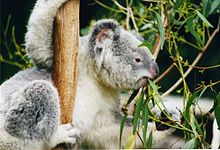Monophagy
Monophagy ( ancient Greek μόνος mónos "alone" and φαγεῖν phagein "eat"), also univory , describes the very narrow range of food or a very narrow food spectrum of specialists who only feed on one or a few very closely related food sources (organisms). In the case of parasites , the term monoxic is established for this. Animals that have a wider range of food to choose from are called polyphagous .
description

A living being is monophag first degree if it is only from a single organism art fed. 2nd degree monophages feed on some species of a closely related group of organisms (host genus), those of the 3rd degree on all species of a host genus. Monophagy occurs mainly in herbivores and in parasitic insects ( parasites and parasitoids ).
The koala lives exclusively on the leaves of certain types of eucalyptus . The panda lives on certain types of bamboo . The high level of specialization in only a few plants and animals as food also means a high level of dependency on the occurrence and distribution of the same. The majority of the approximately 3,000 species of butterflies in Germany are monophagous. If, for example, many of the plant species typical of this type of grassland are displaced by the conversion of poor grassland into nutrient-rich pastures or lawns , the butterfly species that are dependent on these plants also largely disappear there.
See also
swell
- ↑ a b c compare keyword "monophag." In: Herder-Lexikon der Biologie. Spectrum Akademischer Verlag GmbH, Heidelberg 2003. ISBN 3-8274-0354-5
- ↑ Erwin Hentschel and Günther Wagner: Zoological dictionary , Gustav Fischer Verlag Jena, 4th edition 1990 ISBN 3-334-00348-5